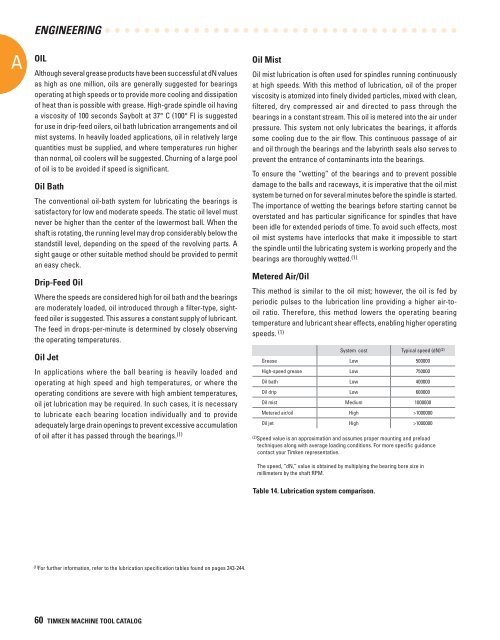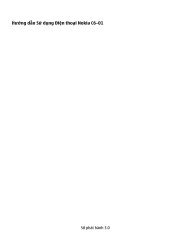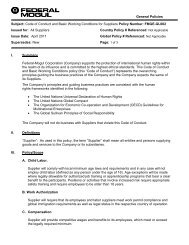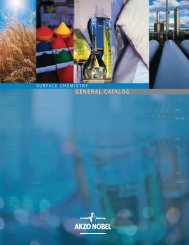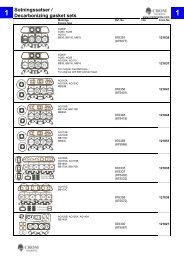Create successful ePaper yourself
Turn your PDF publications into a flip-book with our unique Google optimized e-Paper software.
A<br />
ENGINEERING<br />
OIL<br />
Although several grease products have been successful at dN values<br />
as high as one million, oils are generally suggested <strong>for</strong> bearings<br />
operating at high speeds or to provide more cooling and dissipation<br />
of heat than is possible with grease. High-grade spindle oil having<br />
a viscosity of 100 seconds Saybolt at 37° C (100° F) is suggested<br />
<strong>for</strong> use in drip-feed oilers, oil bath lubrication arrangements and oil<br />
mist systems. In heavily loaded applications, oil in relatively large<br />
quantities must be supplied, and where temperatures run higher<br />
than normal, oil coolers will be suggested. Churning of a large pool<br />
of oil is to be avoided if speed is significant.<br />
Oil Bath<br />
The conventional oil-bath system <strong>for</strong> lubricating the bearings is<br />
satisfactory <strong>for</strong> low and moderate speeds. The static oil level must<br />
never be higher than the center of the lowermost ball. When the<br />
shaft is rotating, the running level may drop considerably below the<br />
standstill level, depending on the speed of the revolving parts. A<br />
sight gauge or other suitable method should be provided to permit<br />
an easy check.<br />
Drip-Feed Oil<br />
Where the speeds are considered high <strong>for</strong> oil bath and the bearings<br />
are moderately loaded, oil introduced through a filter-type, sightfeed<br />
oiler is suggested. This assures a constant supply of lubricant.<br />
The feed in drops-per-minute is determined by closely observing<br />
the operating temperatures.<br />
Oil Jet<br />
In applications where the ball bearing is heavily loaded and<br />
operating at high speed and high temperatures, or where the<br />
operating conditions are severe with high ambient temperatures,<br />
oil jet lubrication may be required. In such cases, it is necessary<br />
to lubricate each bearing location individually and to provide<br />
adequately large drain openings to prevent excessive accumulation<br />
of oil after it has passed through the bearings. (1)<br />
Oil Mist<br />
Oil mist lubrication is often used <strong>for</strong> spindles running continuously<br />
at high speeds. With this method of lubrication, oil of the proper<br />
viscosity is atomized into finely divided particles, mixed with clean,<br />
filtered, dry compressed air and directed to pass through the<br />
bearings in a constant stream. This oil is metered into the air under<br />
pressure. This system not only lubricates the bearings, it af<strong>for</strong>ds<br />
some cooling due to the air flow. This continuous passage of air<br />
and oil through the bearings and the labyrinth seals also serves to<br />
prevent the entrance of contaminants into the bearings.<br />
To ensure the “wetting” of the bearings and to prevent possible<br />
damage to the balls and raceways, it is imperative that the oil mist<br />
system be turned on <strong>for</strong> several minutes be<strong>for</strong>e the spindle is started.<br />
The importance of wetting the bearings be<strong>for</strong>e starting cannot be<br />
overstated and has particular significance <strong>for</strong> spindles that have<br />
been idle <strong>for</strong> extended periods of time. To avoid such effects, most<br />
oil mist systems have interlocks that make it impossible to start<br />
the spindle until the lubricating system is working properly and the<br />
bearings are thoroughly wetted. (1)<br />
Metered Air/Oil<br />
This method is similar to the oil mist; however, the oil is fed by<br />
periodic pulses to the lubrication line providing a higher air-tooil<br />
ratio. There<strong>for</strong>e, this method lowers the operating bearing<br />
temperature and lubricant shear effects, enabling higher operating<br />
speeds. (1) System cost Typical speed (dN) (2)<br />
Grease Low 500000<br />
High-speed grease Low 750000<br />
Oil bath Low 400000<br />
Oil drip Low 600000<br />
Oil mist Medium 1000000<br />
Metered air/oil High >1000000<br />
Oil jet High >1000000<br />
(2) Speed value is an approximation and assumes proper mounting and preload<br />
techniques along with average loading conditions. For more specific guidance<br />
contact your <strong>Timken</strong> representative.<br />
The speed, “dN,” value is obtained by multiplying the bearing bore size in<br />
millimeters by the shaft RPM.<br />
Table 14. Lubrication system comparison.<br />
(1) For further in<strong>for</strong>mation, refer to the lubrication specification tables found on pages 243-244.<br />
60 TIMKEN MACHINE TOOL CATALOG


